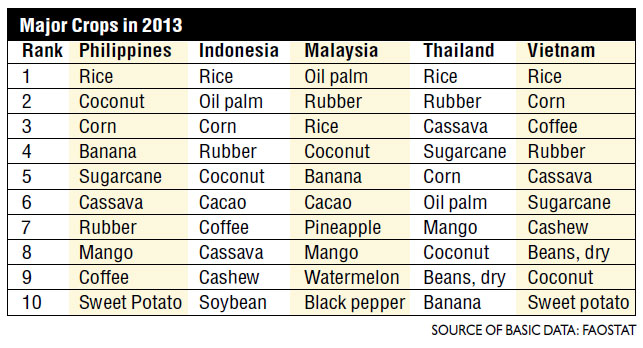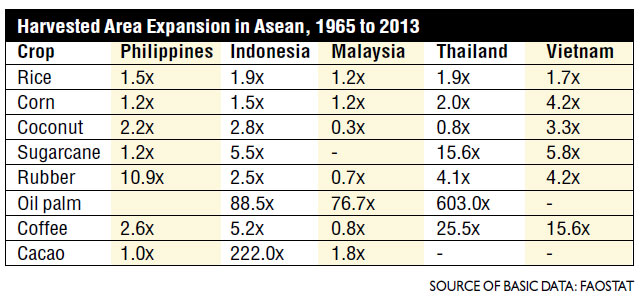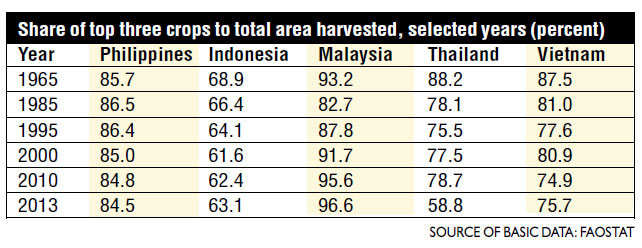Agri-crop diversification: Asean scorecards
Poverty is high in the Philippines for two main reasons. First, farm productivity is low which leads to low income. Second, crop-diversification is poor and as a result, export performance is stymied.
Fragmented farm production does not support a robust agri-food manufacturing and export. Hence, job creation is sacrificed.
This article will describe Philippine farmland diversification during the terms of past Presidents and compare them with Asean countries.
The Presidents are: Ferdinand Marcos, 1965-1985; Corazon Aquino, 1986-1992; Fidel Ramos, 1992-1998; Joseph Estrada, 1998 to 2000; Gloria Arroyo, 2000-2010; and Benigno Aquino III, 2010-2016.
The period covered, 1965 to 2013, is based on available data from Food and Agriculture Organization (FAO) of the United Nations.
The comparison metric would be the shares of the top three and top five to the total harvested areas of 25 crops.
Article continues after this advertisementUsing 1965 as base, and the start of the 20-year Marcos era, the Philippine position hardly changed its dependency for almost 50 years on three crops— rice, corn and coconut.
Article continues after this advertisementIt was 85.7 percent in 1965 and 84.5 percent in 2013. It is second to Malaysia at 93.2 percent and 96.6 percent, respectively.
A key distinction is that Malaysia runs a productive and competitive oil palm industry while shifting away from labor-intensive rubber production.
In comparison, Indonesia, Thailand and Vietnam recorded significant diversification.
Similar narrative can be said for the shares of the top five crops. The Philippine standing marginally changed from 93.4 percent in 1965 to 91.4 percent in 2013. Similar thread can be said for Malaysia.
By contrast, Indonesia’s crop diversification widened from 83.7 percent to 76.6 percent, Thailand from 91.9 percent to 68.2 percent, and Vietnam from 92.2 percent to 84.2 percent.
Rice remains a large part of Asean agriculture, except Malaysia. However, some countries diversified faster than others.
Crop shifts and area expansion
Crop land-use stagnated in the Philippines for more than 50 years. It is an unfortunate story. Notable expansions were made in rubber and coffee.
Indonesia shifted from rice, corn, rubber, cassava and coconut in 1965. In 2013, oil palm surged to No. 2 after rice. Corn, rubber and coconut remained, in that order. The dramatic expansion was in oil palm, coffee and cacao.
Malaysia concentrated on rubber, rice, coconut, and oil palm in 1965 but some areas changed to oil palm, rubber, rice and coconut in 2013. Most notable surge was observed for oil palm, and decline in rubber and coconut.
Thailand had rice, rubber, corn, banana and cassava in 1965. Rice, rubber, cassava and corn remained in 2013. Rubber, sugarcane, oil palm and coffee made substantial gains.
Vietnam was into rice, corn, sweet potato, cassava, and rubber in 1965. By 2013, rice, corn, rubber and cassava remained. Corn, sugarcane, rubber and coffee areas recorded significant strides.
Philippine record
The agriculture sector hardly diversified in the past 50 years. All the Presidents from Ferdinand Marcos to Benigno Aquino III failed to diversify Philippine agriculture. Private sector-driven Cavendish banana and pineapple are perhaps some of the few stars.
The focus on rice self-sufficiency likely caused the concentration of resources on irrigating rice fields and building farm-to-market roads in lowland areas. For decades, corn and coconut lands remained unproductive. Poverty continued to be high.
A country such as Malaysia can specialize but it must focus on productivity and value-chain integration. But the enduring lessons are from Indonesia, Thailand and Vietnam: Productive and diversified agriculture.
It is with hope that the incoming President revisits the country’s agriculture strategy.
(The article reflects the personal opinion of the author and does not reflect the official stand of the Management Association of the Philippines or MAP. The author is the Vice Chair of the MAP AgriBusiness and Countryside Development Committee, and the Executive Director of the Center for Food and AgriBusiness of the University of Asia & the Pacific. Feedback at <[email protected]> and <[email protected]>. For previous articles, please visit <map.org.ph>)



